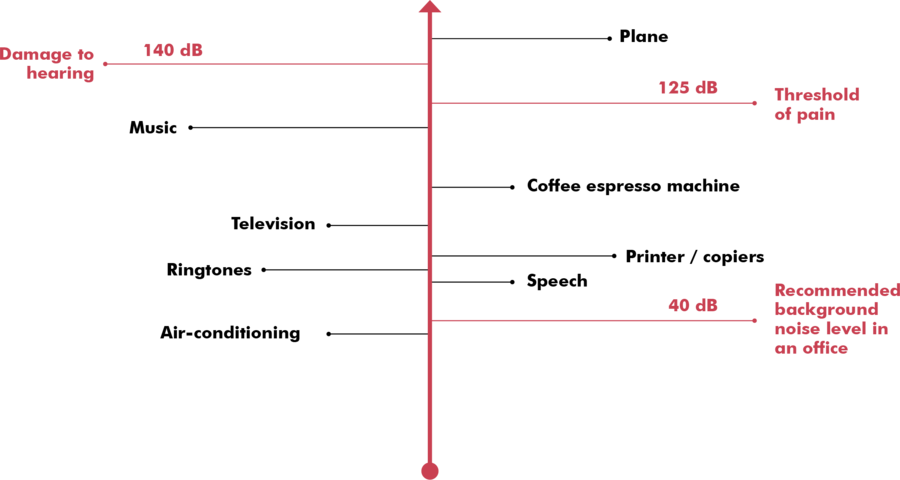If you would like to treat sound within a room, you should start by understanding the basic terminology of acoustics. And, like a lot of things, better acoustic performance begins with solid fundamentals.
What you’ll learn in this guide:
Definition of sound: Frequency, Decibels & Reverberation time
Building acoustics vs. Room acoustics
Principles for good acoustics: Absorption, Attenuation & Diffusion
1. Definition of sound
Sound consists of pressure waves running through the air. It can be described as energy, created by vibrations, transmitted through air or any other medium. The inner ear converts those vibrations into electric signals, which are sent to our brain, where they will be processed and perceived as the actual sound coming in.
These sound waves have two different characteristics:
+ Frequency determines the tone of the sound
+ Decibel determines the intensity of sound
— Frequency: how sound waves travel
The wavelength determines the sound frequency. It is measured as the number of repetitive vibrations per cycle per second and is expressed in Hertz.
The audible range of sound is between 20 to 20 000 Hz. The higher the frequency, the higher the tone. However, for space planning, the suggested frequency ranges from 100 Hz to 5000.
High tones
High frequency | Short wave | 2500 - 12000 Hz | e.g. ringtones, consonants

Mid tones
Speech frequency | Mid length wave | 250 - 2500 Hz | e.g. speech

Low tones
Low frequency | Long wave | 50 - 250 Hz | e.g. HVAC, vowels

— Decibel: the intensity of sound
Decibel is a logarithmic unit to express the ratio of sound intensity (volume) and is important as an indicator of the background noise level. Humans can hear sounds between 0 and 140 decibels. The value of decibels has no direct or indirect correlation with the sound frequency.
For example, the ticking of a clock and the buzzing of a vacuum cleaner may have the same frequency but a different volume.
Why it matters? In today’s open-plan workspaces, employees are exposed to noise pollution. The level of noise ranges from 60 to 80 decibels, whereas recommended background noise level in an office is around 45 dB.
Noisy offices above the suggested threshold may hamper:
+ concentration
+ interfere collaboration
But there is always a way to avoid getting stressed by trying to keep focus at work. The solution could be several workplace microenvironments, designed with sound balance in mind for the activity and the people using these areas.

— Reverberation time: the time for a sound to drop dead
Reverberation time is the time needed for an original sound source to decay 60 dB and is expressed in seconds. In order to generate excellent speech intelligibility and clarity, the reverberation time should be adjusted and balanced by means of absorptive material in function of the specific acoustical issues in a given space. The reverberation time will always be influenced by
+ the volume of the room,
+ room temperature, and
+ existing absorptive materials in the room, e.g. materials, objects, and people.
Recommended reverberation time for different spaces:
+ Office: 0.75s
+ Meeting room: 0.60s
+ Cafeteria: 1.00s
+ Gymnasium: 1.50s
+ Auditorium: 1.50 to 2.00s
ry measuring the reverb time in your space with the BuzziSpace RT60 app. It allows you to simulate the improvement in room acoustics by adding sound-absorbing furniture. Download the app in the App Store, available for both iPhone and iPad.
Why it matters? In an office, high reverberation intensifies the existing distracting sounds, as the sound reflects from walls and tables, among other hard surfaces. For instance, reverberation may cause:
+ Difficulties to understand your conversations with colleagues
+ Distractions due to people speaking at the other end of large spaces
The way to dampen reverberation is with absorption materials

2. Building acoustics vs. Room acoustics
— Building acoustics
Building acoustics and room acoustics may sound like two sides of the same coin, but don’t be fooled. We have to make a clear distinction, as the solutions to treating problems associated with either of the two are very different. As the name implies, building acoustics has to do with the building and the transmission of sound from outdoor to indoor and between structural elements of a building, e.g. floors and walls.
This is the case when:
+ Sound is transferred from outdoor to indoor, e.g. cars, trams, airplanes passing by
+ Sound is transferred between floors, e.g. footsteps from the floors above
+ Sound is transferred between adjacent rooms, e.g. an adjacent meeting room
Ideally, issues like these should be addressed by the architectural team through the insulation of windows, walls, ceilings, and floors. Another option is to remedy the transmission of sounds, so they will not escape the room, to begin with.

— Room acoustics
Room acoustics, pertain to noise and sounds within a room or any given space. Rather than focusing on insulation to remedying transmission of sounds, the key to room acoustics is absorption to prevent sound waves from bouncing back-and-forth in a room.

3. Principles for good acoustics
To create a better acoustical environment and reduce reverberation time in a room, BuzziSpace acoustic solutions are developed to perform on one or more of the following acoustic principles.
— Absorption
Sound Waves are absorbed by any acoustically soft material they encounter.

Sound is energy, and in order to stop this energy from propagating, absorptive panels must be used to convert this energy into heat through friction. The absorption coefficient of a product will determine the level and quality of absorption. Absorption solutions can be applied to fixed wall or ceiling elements, e.g. BuzziBlox, BuzziLand, BuzziPod.
Attenuation
Reducing the sound transfer within a room.

In order to reduce the sound transfer between different spaces, vertical elements will be applied to cut down sound energy, either pending from the ceiling or free-standing. Those can come in different shapes such as vertical ceiling panels, room dividers, desk screens along with some a range of acoustic essentials. Never underestimate how attenuation or sound dampening has a positive impact on speech intelligibility and clarity. It’s no wonder that a positive acoustic experience that absorbs disturbing sounds leads to a quieter place, fosters focus and inspires effective collaboration within an energetic workspace.
Diffusion
Sound energy is spread evenly in a given space.

Wavelengths, which can’t be absorbed through acoustic treatment, will dissipate evenly back into the room, ensuring a better spread while maintaining a live, vivid sound. Otherwise, the sound will be reflected back in a linear way, resulting in a remaining unpleasant sound. This property can be obtained by alternating different depths of absorptive material and 3D shapes such as BuzziTile 3D and BuzziBrickBack. Check out other solutions.
(Cre_buzzi.space)
Xem định vị:
- Tổng công ty: Cụm Công Nghiệp Lại Yên, Xã Sơn Đồng, TP. Hà Nội.
- Kho Mỹ Đình: Đối diện 304 đường K2, Cầu Diễn, Nam Từ Liêm, Hà Nội.
- VP Trường Chinh: Số 36, ngõ 120 đường Trường Chinh, phường Kim Liên, TP. Hà Nội.
- Nhà máy: KCN Bình Phú, Phường Kỳ Sơn, Tỉnh Phú Thọ.
- Chi nhánh Đà Nẵng: Số 575, Đường Lê Văn Hiển, Hòa Hải, Ngũ Hành Sơn, Đà Nẵng.
- Chi nhánh Sài Gòn: Số 181/7 Dương công khi, Ấp 9, xã Hóc Môn, TP. Hồ Chí Minh.
* Để rõ đường đi và thuận lợi cho đôi bên Quý khách vui lòng Click vào đây để xem chi tiết.